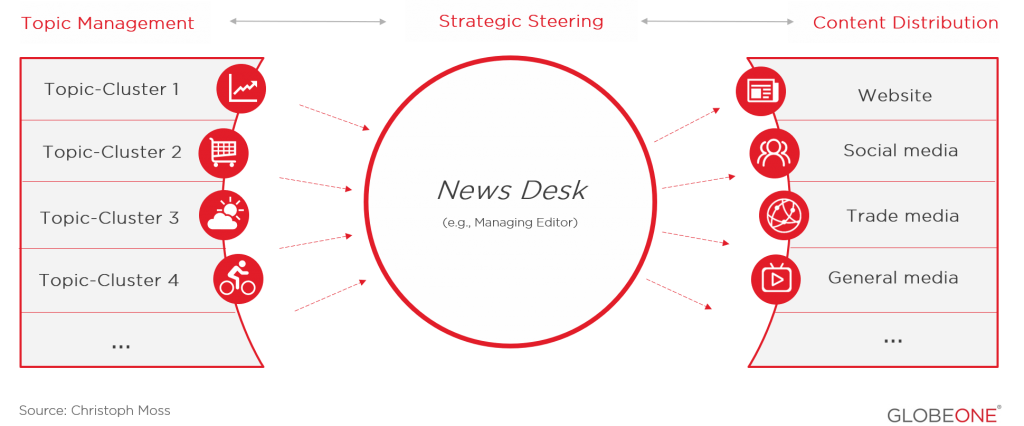If you had talked to communications managers about a “corporate newsroom” five years ago, they would have blamed you to use an oxymoron. Five years forward and you can hardly count the number of companies that have started to organize their storytelling like a modern-day newspaper. These companies do not only set up editorial plans and structure column responsibilities. The most far-reaching concepts even include a brick and mortar newsroom. In these corporate newsrooms, editors are implementing a tailor-made strategy which is designed to run perfectly fitting stories and posts in all available media formats including blog posts and videos for a carefully targeted audience. The alleged oxymoron has turned into a reality filled with life by future-bound brand professionals who want to stay ahead of fundamental changes in the media environment. Content marketing also carries forward its triumph all the way into B2B, where customers are traditionally approached in a more conservative way. According to the Content Marketing Institute, the ratio of B2B marketers using content marketing has already reached 89 percent.
Fighting The Silo Mentality
It is all about a simple concept: In a hitherto analogue news universe, which is rapidly expanded by a digital orbit with an exploding number of channels, it is getting more difficult by the day to consistently communicate on all relevant channels. The communicative integration across all channels in terms of form, time, content and dramaturgy is one of the biggest challenges. In this growing universe, an increasing number of brands is competing with storytelling on traditional media and social platforms for the attention of carefully selected target groups. But while the number of available media formats and presentation forms is growing swiftly, many corporations are restrained by a silo mentality which doesn’t meet the requirements of this new media reality: PR, marketing, internal and external as well as digital communications – not to forget neighboring departments – are working behind invisible walls, producing their insulated and narrowly gauged content. This lack of synergies is hardly a good precondition for exciting and informative stories.
This critical shortcoming is addressed by tearing down the walls between classical corporate communications departments based on the model of disbanding the different desks in classical journalism. Reality teaches us that in larger companies raw information for content creation – studies, reports, manuscripts or polls – is more scattered around without being used. And if it is used at all, it is not utilized effectively. Pretty often the result is redundant research because various departments are collecting information on their own. In many cases responsibilities are neither determined nor pooled, the editor in charge is non-existent. This is more than unfortunate since storytelling continues to become more important in a world where brands want to differentiate themselves in a marketplace suffering from information overload. This holds even more true for industries in which cost-benefit-ratios are converging. In this setting corporate communication can make all the difference. But if you fall asleep you fall behind in the competition. No surprise then, that the Poynter Institute for Media Studies labels corporate newsrooms „the fastest growing newsrooms of the 21st century.” In its magazine “Perspectives”, Cognizant, a leading technology solutions company, even refers to a „content war.”
Priority On Content and Topics

A corporate newsroom facilitates the proper pooling of communications capacities and competencies, as well as the realization of story ideas. The focus is clearly on lean processes in order to achieve synergies. A pragmatic newsroom concept breaks down the silo mentality and improves internal cooperation as well as transparency. In the process, it becomes easier to identify good story topics, make decisions more efficient and eliminate redundant research. The pooling of manpower and editorial capacity make it possible to train and appoint topic experts.
At the same time edited posts, videos, tweets and brand-related magazine features can be dispensed more effectively into traditional and digital channels and placed closer to the desired audience.
In this communicative and cooperative team environment it will be easier to promote a more journalistic approach and prioritize topics over distribution channels. The first step is finding the idea for a story, then conducting research. Only after that the channels are selected for the best impact. The result is a more content-driven, brand-oriented, tailor-made, relevant and agile storytelling. Digital tools, e.g. content management platforms, can help with the better coordination and more efficient content organization. However, software alone does not break down the silo mentality and in worst case scenarios it won’t be even used by the employees. The launch of such tools therefore must be accompanied by a professional cultural change process that creates acceptance for the solution among the employees.
Signaling Into The Whole Corporation
Thanks to its advantages the newsroom concept will radiate positively into the whole corporation. If possible, the use of interactive and digital communication channels needs to be aligned with the overall communication concept of the corporation. The editorial team will experience itself as a creative lab furthering the brand development. The value added to the brand will be visible. Thanks to the condensation of topical and other media competencies the newsroom communication will have more weight and persuasiveness within the corporation, especially towards the C-Suite. This way, experts in charge of either the topics or the distribution channels contribute to a more purposeful positioning of decision makers and the whole organization. Just when the mass media is faced with an enormous loss of trust and a fierce competition for the attention of their audiences, communicators are in growing demand as strategic consultants.
With all being said, traditional analogue communication remains important, but digital is the new news standard. Successful digital brands can make the audience feel like they are everywhere. In a single day, there might be a feature story in a printed magazine, a video on YouTube, pictures on Instagram, an electronic newsletter and a TV interview with the CEO. Creativity is the limit.
In order to keep up with the digital transformation, the newsroom team needs to learn the necessary digital skills. Otherwise job openings need to be filled with external candidates. The new multimedia environment requires skills that significantly exceed traditional journalistic qualifications. Exciting visualized content for example is not an end in itself. It needs to convey the key message at least as well as the underlying text. In our era of informational compression pictures and videos have become an indispensable ingredient for engaging content. Postings on social media platforms, meanwhile, do not only need a decent visualization, they are also less formal and more interactive. Videos and live-streaming, which are highly popular among the social media audience, need to be aligned with the communication concept. In B2C marketing many companies already design their own digital channels and tools, among them apps, in order to communicate with their respective target groups directly. It is obvious that these new challenges need to be kept in mind when the corporate newsroom is conceptualized and constructed.
Roles and Responsibilities in The Content Hub
The roles and responsibilities in the newsroom must be unmistakably defined. A strict content orientation, lean processes, transparency and team spirit are essential ingredients for success. To make sure this works, there are topic managers and channel managers who are recruited from the existing communications departments. An editor-in-chief chairs the regularly scheduled editorial meetings. Basically, these editorial meetings work like a hub that connects the content with the channel side. The editor-in-chief, or a little team in his stead, has the final say. He approves the release of the content, chooses the channels for publication and determines in which order different posts are published.
The topic managers´ task is to identify important subjects and develop the proper stories. The channel manager determines the channel-specific adaptation and tracks the content in order to identify how target groups respond to the output. This ensures the necessary feedback into the editorial team which in turn helps to optimize the tailoring of the creative content. Topic managers are also entrusted with actively gathering information, quotes, data, speeches and pictures and they act as ambassadors for their respective topics within the organization. They specify the angle of the story and compilate material for illustration. It is important to trim reports, feature stories, videos and posts for social media use and visualize them accordingly.
There is no way around regular editorial meetings, not only because many ideas are born during conversations. The more journalistic the approach and work in the newsroom the more precise and reliable the coordination and feedback necessary for reviewing the results. In small and medium-sized firms, where a newsroom cannot be specifically built and team members meet on a regular basis anyways, an informal editorial routine might be enough. A close affiliation to the strategic management level is crucial, since the implementation and purpose of the storytelling need to be aligned with the company´s overall strategy. An editorial schedule as well as pre-defined templates will be helpful for briefings, adhering to deadlines and keeping all newsroom members on the same page.
Lean Corporate Communications Increases Agility
In some cases, the big bang may not be possible and the architectural newsroom – for whatever reason – not be constructed. But in small companies it is often enough, to direct the operational focus to the processes and the cooperation between the various communications disciplines. The main goal is to control as effectively as possible the creation of an exciting and engaging story about – or related to – the brand, even if it is only a simple press release. Clarifying the topic competences and organizing a constant exchange between the team members, is the first and most important step.

At the same time, the newsroom staff needs to be involved in the conceptual phase in order to gain its acceptance for this organizational advancement.
In view of the rapid upheaval caused by digitization, lean processes are a necessary prerequisite for avoiding friction losses and inefficiencies. Lean corporate communications that promotes good stories is ultimately not an end in itself, but part of a superordinate requirement for companies. Only by becoming more agile do companies keep their chances of turning this acceleration into a competitive advantage. Agile companies are more flexible, they can react more quickly to new decisions and above all they do not lose sight of the consistent focus on the respective stakeholder groups. But the ability to tell stories that are equally exciting and informative is not something a company is blessed with from its inception. At the same time, it is nothing that cannot be learned. But exciting storytelling needs the necessary precondition. And this, without a doubt, is a functioning newsroom.



